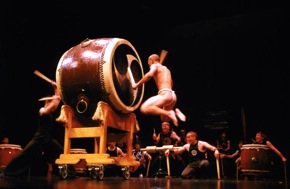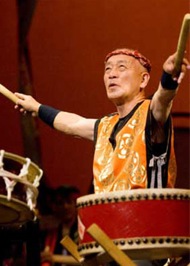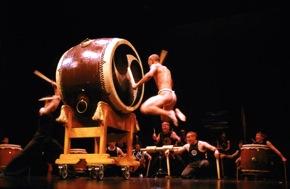“Most people just listen,” said Seiichi Tanaka, grand master of the San Francisco Taiko Dojo, founder and host of the 42nd Annual International Taiko Dojo Festival, which featured three shows at the Novellus Theater at Yerba Buena Center in San Francisco over the Nov. 6-7 weekend. “I want people to not only hear the sound, but also watch the sound, see the sound, feel the sound.”

O-sensei Tanaka’s words proved descriptive of the concerts. Besides the enormous sound of massed taiko drums and other percussion instruments, plus the shouts, cries, and timing signals of the drummers, the event proved to be a synesthetic pageant. The costumes and the explosive, sometimes sinuous movements of the performers were the foreground to the almost palpable group commitment and personal good feeling radiating from them. And indeed the backstory of Taiko Dojo and of the Taiko Festival’s remarkable success tells of constant and renewed group effort and community building, reaching more than 15,000 students to date.
Tanaka — whose title, an honorific that more or less means “great teacher,” was bestowed on him by the principal Japanese taiko foundation — is the only O-sensei outside Japan. He first grasped his mission on a visit to San Francisco in 1967, when he realized that the Sakura Matsuri — the Cherry Blossom Festival — in Japantown didn’t feature taiko drumming, as is traditional in Japan. Looking into it further, Tanaka discovered there were no taiko performances at the time, anywhere in the U.S. He debuted the next year, solo, as the first drummer to play at San Francisco’s Matsuri.
Musical Athletes Who Move

Tanaka was born in Tokyo in 1942, the son of a professional baseball player. The athleticism of his background shines through every moment of Taiko Dojo onstage, as well as in his own playing and presence, tempered by his supply of sometimes-goofy humor. There were moments at Sunday afternoon’s show when the combination of the onstage action; the leaping, whirling entrances of performers, cheered on by their fellows; and the vigorous reactions of the audience were almost identical to the outpouring the Bay Area just witnessed with the Giants’ World Series win.
This kind of group exuberance, on both sides of the proscenium, isn’t unusual in the Japanese performing arts, as anyone who’s attended a performance at the Kabuki-za in Tokyo knows — especially if you’ve sat in the balcony, where ardent fans leap to their feet with stylized epithets when a favorite actor sets foot on the hanamichi, the “flower-path” ramp leading through the audience to the stage. Taiko’s also a popular art, but one usually performed out-of-doors at festivals and shrines on holidays. It delves deep into folk custom, creating a past-and-present sense of community.
Featured Video
2010 S.F. Taiko Festival Finale Captured by audience
member Michael Jeong
And, thanks to Tanaka’s efforts, it has taken root in a number of communities throughout North America, as amply demonstrated by the performances at the Festival of Sacramento’s estimable Taiko Dan; Kaminari Taiko of Houston; and by Stuart Paton, the leader of Burlington Taiko in Vermont; as well as the brightly costumed, dancing Grrrl Brigade and the Taiko Dojo Rising Stars.
The opening, with members of the S.F. Taiko Dojo and Osuwa Daiko from Japan onstage, set an upbeat tempo for the two-and a-half-hour event. Two opposing ranks of drummers, arrayed side-by-side in complementary colors, leapt into action, at one point alternating rank on rank, drumming with one stick while pointing across at their fellows with the other stick and shouting out. Transverse flutes played simple folk tunes. Gongs and hand percussion added to the massy sound. Down in front, seated on the floor, were Tanaka, along with Kasumi Oguchi and Makoto Yamaguchi, daughter and grandson of his mentor, the late Daihachi Oguchi, who founded Osuwa Daiko (making its debut at the Festival). The deep pulse and driving rhythms, varied by impressive batteries of instruments and gleeful showmanship, set the house rocking with energy.
Taiko, and All That Jazz
Osuma Daiko, led by the superb drumming of Makoto on his grandfather’s signature piece, Flying Dragon, showed something of the complexity this former professional jazz drummer brought to his modern conception of taiko ensembles. From the early 50s, Oguchi slipped in riffs from his drum-kit days to the old taiko solo pieces and adapted them to group playing. There were moments in the Oguchi piece, arranged by Tanaka and with Makoto’s charismatic leadership and playing, that sounded a little like something by Art Blakey or Elvin Jones — “Circle of Sound,” indeed!
I was sitting with some volunteers for the Taiko Dojo, middle-aged folks like me, emphasizing again the cross-generational appeal of the art. After I mentioned to the genial man next to me that I had toured with Theatre of Yugen, along with Tanaka-san as our splendid drummer, 27 years ago, he turned to me at one point and asked, “Is this what Taiko Dojo was like back then?”
No, it wasn’t. The extent and variety of this music, as well as the dedication of its many adherents from all over the continent, thrilled the sold-out audiences packed into Novellus Theater. It was a testament to the dedication and long, hard work of Tanaka and company, making a Japanese folk custom from Shinto shrines into something as All-American as soccer — er, baseball.

